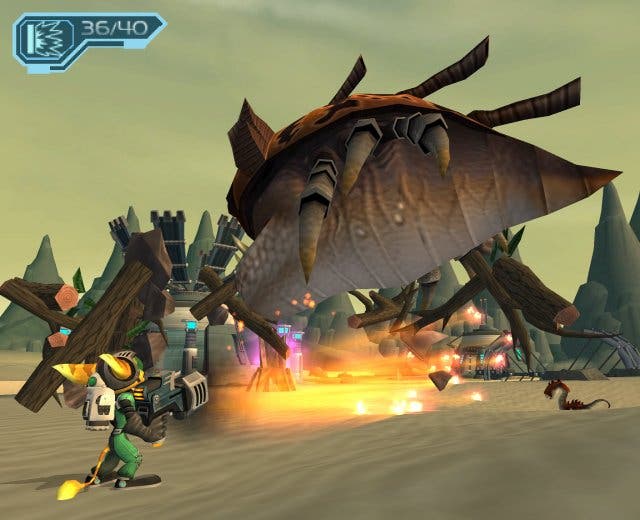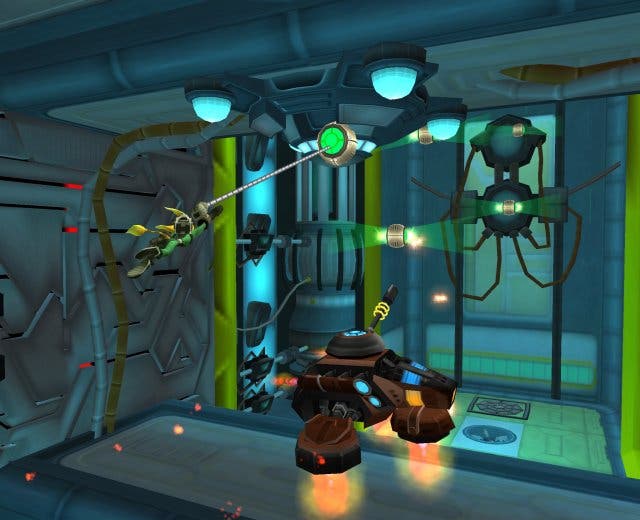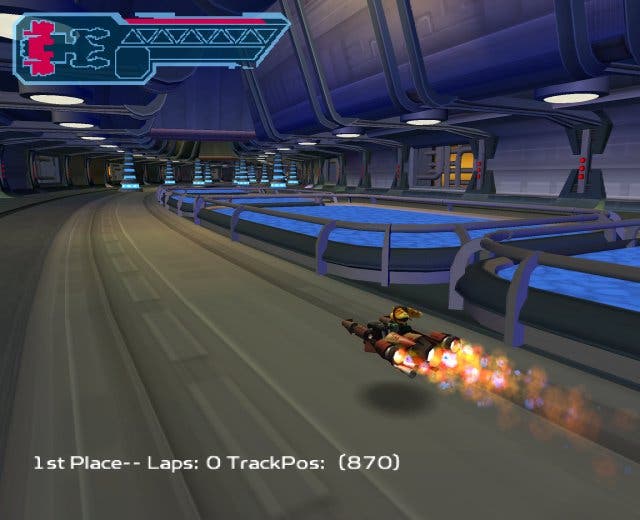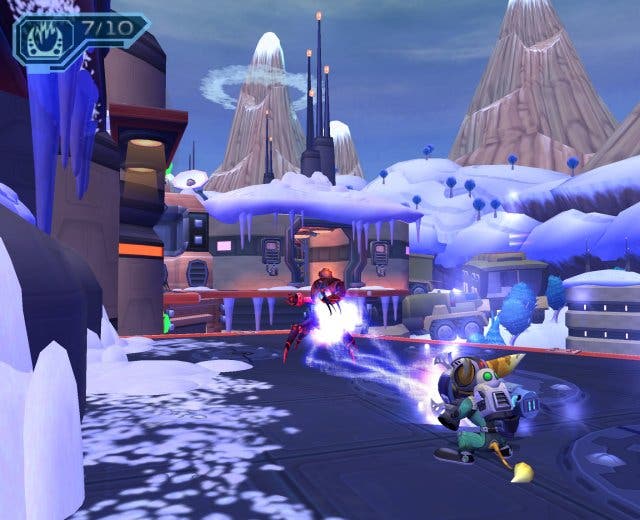Ratchet & Clank 2: Locked & Loaded
Cast your eyes down to read what Insomniac thinks, then click here to see what we make of it...

Some games are engrossing, right out of the box. Some games you can pick up in an hour or so. Some games, though, take a little longer to grow on you, eventually keeping you up until the early hours and shredding your meticulously planned social calendar like an Enron invoice. But it takes some getting there. Ratchet & Clank, on the other hand, was brilliant, exciting and a guaranteed hit before it even made it onto a DVD.
The key to its success? Jak & Daxter. Sure, the two turned out to be very different games in a lot of ways, despite the shared love of ampersands, publisher, dual character mechanics, collect 'em up frenzies, and huge, sprawling platform environments wrapped in feature-quality visuals, but it was Jak's success and the promise of a shared technology and design ethos that had platform fans running short of saliva in the run up to its release. And then it delivered arguably as much as Jak ever did anyway, mixing 3D platforming with a love of crazy weaponry and gadgets (with absolutely loads of guns locked away in the game), an amusing plot and some memorable bad guys.
Understandably then, we've been pretty bloody excited ever since we finished Jak II: Renegade. If Naughty Dog could deliver such a massively improved platformer within two years, clobbering genres together and gluing our thumbs to the pad with consummate ease, imagine what Insomniac Games, masters of Futurama-style humour and quirky characters like Captain Quark, could do with the sort of technological headstart that Jak II offers...
Ratchet & Thunk...

But then, about half an hour into Ratchet & Clank 2, we encountered a feeling we really hadn't been expecting - we were disappointed. After the opening scenes of Jak II, which saw our hero hurtling through time, split from his friends, tortured for two years and then plunged into a city-wide resistance movement out to topple a malevolent dictator, R&C2's "what should we do now?" opening was a damp squib. There was no new angle to explore, like Jak II's Haven City, no obvious graphical improvements to amaze and astound, and no real thrust to get us going - just feline-looking mechanic Ratchet and his robot buddy Clank sat in recliners telling a TV documentary crew that nobody seems to need a hero any more, before being whisked away and set to work by the waffling CEO of MegaCorp - the necessary replacement for R&C's Gadgetron fellows.
Fortunately though, once you stop comparing it to Jak II and concentrate on what you're playing, Ratchet's second adventure is thoroughly enjoyable and much more vast. Weapons are bigger now, and can now be upgraded through repeated use. Ratchet himself gains experience through repeated play, earning more health points throughout the game and even uncovering the odd artificial health booster to jump a level, and enemies respond with more complex attack patterns, better AI and more hitpoints. Levels are bigger, with more objectives and hidden areas. There are more mini-games (now "mega-games" as Insomniac president Ted Price tells us elsewhere today), which allow you to compete for more of the game's currency, bolts, by taking on more enemies and tougher levels. There's more of Clank, including some War of the Monsters-inspired planetary stomping that uses his mech suit from the first game to great effect, and the return of his 'nanobot' levels, now with bridge-builders and worse. And, of course, there are far more weapons and gadgets than ever before.
Weapons and gadgets are of course what really set Ratchet & Clank apart from Jak & Daxter, and perhaps Jak II's futuristic, sci-fi setting (complete with Dune overtones - spice/eco, Harkonnen suspender pods, etc - and four choice weapons) was something of a spoiler for R&C2 in this case. After all, not only did Jak compete on a platform front, it now had its own array of weapons to worry about. Given that R&C2 follows much the same formula as its predecessor (right down to the way levels - planets - are split into a couple of main routes, always rewarding you with coordinates for the next level, and mini-games break up proceedings), Jak II does more than complement it now - it steps on Ratchet's toes.
Jak who?

The good news though is that by the time you get your hands on some of the treats in Ratchet's 2003 arsenal, you've almost forgotten what Jak's functional foursome were altogether. There was a shotgun. Um. And a machine gun, yes. Maybe two of them. What was the other one? Oh wait, I don't really care, because I'm busy piloting spiderbots through gaps and blowing things up to open secret doors, slashing through wormy desert-dwellers with an almost lightsabre-esque lava gun, firing rockets at choppers, slingshotting Spider-Man style across levels, hang gliding through lava canyons and robot factories, dragging robotic foremen onto security pads to open doors, and firing pint-sized nuclear devices at armies of Thugs For Less mercenaries sent to undo my bidding. Peacemaker? Sod that, gimme a Visibomb launcher any day.
Before I get carried away though, it's probably worth fleshing out what little plot there is in R&C2 and going over some of its core strengths. After all, anybody coming to this off the back of Jak II, as I am, will probably be expecting something borderline serious. However Insomniac makes no effort to hide the fact that Ratchet and Clank are just average folks in a rather self-parodying universe full of one-dimensional, joke characters, and if you can't get over that then you're going to get bored. The plot, such that it is, has the daring and occasionally dense duo fighting robots in pursuit of a masked villain, who has stolen a secret project - a demented-looking, toothy blue fur-ball that MegaCorp has big plans for - and must be tracked down. Obviously this would be a lot easier if MegaCorp bigwig Mr. Fizzwidget was capable of keeping our heroes up to date on proceedings, but in true comedy style, he is not, and even manages to work to their detriment. Before long, we're faced with a complete about-face, lots of unhelpful goings-on and the threat of the blue furb' getting out into the open. And, of course, things are not what they seem.
It's never less than silly. Fans of Captain Quark (definitely the most enjoyable and memorable thing about the first game) will be pleased to hear that he makes an appearance, but perhaps not as you'd expect (and he's no longer working for Gadgetron's minimum wage, either), but without his direct contribution, the script is a bit worse off. Fizzwidget made us laugh out loud on several occasions (it's the way he uses long and wrong words as if he has no idea - "Affirmulous!" etc), as did TV ads and programme snippets, but R&C's knowing winks and plank-thick robots aren't a patch on what we had before. What's more, Clank may be smart but he's no replacement for Daxter's acerbic dialogue and regular tirades, and what 'twists' there are don't really compare to some of Jak II's revelations, particularly the big one right at the end.
As for the rest of the basic game, it's a simple enough beast. Ratchet is the one you generally control, and he can run, jump (X), double-jump (X twice), attack with his wrench (square), duck (L1), duck jump, hover in the air using Clank's chopper or boosters, and operate various forms of machinery. He also picks up more abilities (not to mention the ubiquitous guns - accessed from the menus or bound to one of eight directions on his 'Quick Select' control) as the game wears on. And with his skills, he leaps from platform to platform, cutting his way through his wacky space adventure.
More, more, more

But then, there's something really very compelling about Ratchet & Clank 2 that makes it stand above its rather humble fundamentals. Whether it's the constant progression of more health, more weapons, more gadgets on a level-by-level basis, the craftsmanship that's gone into some of the level designs, the wide variety of objectives and gameplay styles, the amount of collectibles and things to buy, the little puzzle elements, the space shooter sections (ok, probably not them, they're painful), or just the actual platform design, it's difficult to say at this stage, but something had me playing this for six hours straight on Sunday afternoon, and it wasn't a sense of obligation, I can tell you that. (Although I'll tell my boss something else.)
There is obviously only so much you can do with a 3D platformer using this level of technology, so it's a good thing that Insomniac has managed to do so much. Towards the end of R&C, you could argue that it just went back and forth between rooms of enemies and rooms of crates with a few slingshot/jumpy bits, but R&C2 is a lot more diverse - the desert world level about five hours in, for example, has you shooting your way out of the heart of a volcano, jumping chasms and lava lakes, and slicing enemies on one front, gliding through canyons on another, and hackandslashing your way to a big bolts total out in the vast, uncharted desert beyond the pad where your ship is waiting. Another level has you riding a platform past and dodging obstacles with the action viewed side-on, fighting your way past projectile-packing enemies and gun turrets, and then competing in a huge arena and in hoverbike races for bolts, gravity boots and other trinkets. Still another has you climbing down the side of a building with your gravity boots, shooting enemies as they stick their heads outside windows to take a pop, and then you get some of the grinding sections to boot.
And then of course there are various elements to break all this up. You may remember the little puzzles thrown into the last one, but now when you see what looks like a plug hole and socket your latest tool, you have to manipulate switches to fire up circuits, rotating little connections using the circle button so that increasingly speedy electronic pulses can move along a grid without hindrance; or map your way around a circular locking mechanism to create a circuit and pick the lock. They're rather contrived, perhaps even pointless diversions, yes, but they help to break up the action and they add to the 'completeness' of the world. It's never just about running, jumping and shooting.
Testing your metal

Some of the main levels also boast rather ingenious puzzles, like a flooded factory that springs up just after you've found a gun that turns water into ice and back again. Faced with a rising and sinking pool of water (complete with a vicious robotic shark), you're forced to judge the rise and fall and solidify the pool at just the right height that you can slide across and through a tunnel and still jump comfortably to reach the platforms on the other side.
Naturally with such a vast collection of guns, sometimes things do boil down to all out warfare, and these are perhaps the toughest sections of the game that we've witnessed. In fact, there are some definite balancing issues in our build (labelled 'Review', but we're not convinced - or allowed to - just yet), including one section where our respawn point was way beyond the nearest MegaCorp vending machine (for restocking on ammo, etc) and we kept dying. Although this forced us to be creative and call on some of our lesser-used weapons to avoid confrontation and conserve ammunition, this isn't the style of the game in general. In general, ammo vendors are suitably placed that you can retool before reattempting sections. Now, if Insomniac wants to force us to tap more of our arsenal, then we hope to see more sections like this further into the game - you could even argue it makes up for the "infinite lives" technique used in R&C and J&D by giving you only a certain amount of resources before you're basically forced to reload - but really we'd just like a bit of consistency, which, to be fair, the game otherwise manages without too much trouble.
One positive thing we can say about the shooter sequences though - and in general - is that the camera is far more forgiving than Jak II's, which seems diametrically opposed to your interests during some sections (and is absolutely dire during the final boss encounter). R&C2's camera is usually on the money, although it did have trouble with our perspective-switching gravity boot antics on occasion. We're also pleased to find a first-person mode, allowing us to target enemies with more precision - it's particularly useful when twinned with the plasma rifle, which is basically R&C's sniper gun.
As this isn't a review, we'll save you our opinion on R&C2's visuals for now, but suffice to say it looks very much like its predecessor, from the character and ship models and box/bot-smashing animations to the low-texture, high-poly environments and weapon graphics. Each new level is presented without much fanfare - just another sprawling, incredibly detailed landscape to investigate, with a couple of streams of bolts heading down a couple of obvious tangents - and the range of colours and environments is vast, even though your first visit to the lava and ice worlds won't be capped with quite as much jaw-refastening excitement as they were in the original. Still, it's amazing to see a PS2 do all this without breaking a sweat - remember some of the crap we used to play in 2000? Amazing to think it's the same console.
Insomnia as a career choice
Overall then, our first few days with Ratchet & Clank 2 have been at times disappointing, exciting and most of the time just plain enjoyable. Progress is steady, everything we liked about the first one is back with the requisite "more", and it seems to be a lot longer and more imaginatively broken up than its predecessor - by the time 12 hours rolled around on our R&C save clock, we were on the final boss, but we're still going strong here. Obviously only time will tell whether R&C2 can catch up with Jak II's improvements - and we have our doubts - but despite our first impressions, that "If you only buy one platformer this year" statement is going to be harder than ever to nail for Christmas 2003. We'll let you know if we've made our minds up sometime prior to R&C2's November 21st release date.

